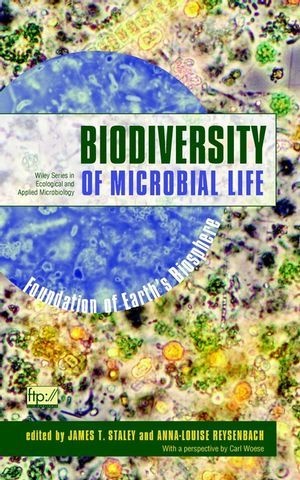Read more
Informationen zum Autor A professor in the Department of Microbiology at the University of Washington, Dr. James T. Staley received his Ph.D. from the University of California, Davis in 1967. He also serves as Chairman of Bergey's Manual Trust and holds positions on the editorial boards of Geomicrobiology, Diversity and Conservation, and Environmental Microbiology. His primary research interest is general microbiology with an emphasis on microbial evolution, diversity, ecology and bacterial taxonomy. Klappentext Biodiversity of Microbial Life places the importance and novelty of the diversity of the microbial world in perspective with the biodiversity of plants and animals. Microbial diversity has driven the evolution of all life on Earth as well as the nutrient cycles, which are key to the operation of the biosphere. Microorganisms live in all ecosystems, even extreme environments not habitable to other organisms. Noted experts including Carl Woese, the originator of the Tree of Life, and Rita Colwell, who is now Director of the National Science Foundation, offer their unique perspectives on the extent and importance of microbial biodiversity. Special emphasis is placed on:* Evolution, speciation, and contrasts between microbial biodiversity and plant and animal biodiversity* Physiological and metabolic diversity of microorganisms* Biodiversity of microbial life in terrestrial and marine environments* Symbioses between microorganisms and plants, insects, and humans* Extreme environments populated exclusively or primarily by microorganisms including thermal vents and hot springs, polar sea ice environments, and subterranean ecosystems* Microorganisms and biotechnologyBiodiversity of Microbial Life is an essential resource for all biologists interested in biodiversity. Zusammenfassung Dieses Buch diskutiert alle wichtigen Fragen zum Thema mikrobielle Biodiversität. Es erklärt genau, wie diese sich von der pflanzlichen und tierischen Biodiversität unterscheidet und wie sie entstanden ist. "Biodiversity of Microbial Life" enthält Beiträge von renommierten Experten aus aller Welt und bietet so eine einzigartige und umfassende Informationsquelle zu diesem Thema. Es ist das bislang einzige Buch, das die mikrobielle Biodiversität vom molekularen Standpunkt aus betrachtet und auch die Mikrobiologie, Aspekte der Geowissenschaft und Planetenforschung mit einbezieht. Behandelt werden u.a folgende Themenschwerpunkte: physiologische - und Stoffwechsel-Diversität, mikrobielles Leben an Land, im Wasser und in extremen Umgebungen, mikrobielle Symbiosen und der Einsatz von Mikroorganismen in der Biotechnologie. Inhaltsverzeichnis Preface. Contributors. Perspective: Microbiology in Transition (C. Woese). PART I: EVOLUTION AND DIVERSITY OF MICROORGANISMS IN ECOSYSTEMS. A Microbiological Perspective of Biodiversity (J. Staley). Natural History of Microorganisms Inhabiting Hot Spring Microbial Mat Communities: Clues to the Origin of Microbial Diversity and Implications for Microbiology and Marcobiology (D. Ward, et al.). Microbial Mats and Biofilms: Evolution, Structure, and Function of Fixed Microbial Communities (A. Teske & D. Stahl). PART II: PHYSIOLOGICAL AND METABOLIC DIVERSITY OF MICROORGANISMS. Evolution of Energy Metabolism (J. Leigh). Evolution and Diversity of Photosynthethic Prokaryotes (B. Pierson). Diversity of Microbial Heterotrophic Metabolism (J. Perry). PART III: MICROBIAL DIVERSITY OF MAJOR ECOSYSTEMS. Exploring the Diversity of SoilA Microbial Rain Forest (D. Buckley & T. Schmidt). Marine Prokaryote Diversity (M. Suzuki & E. DeLong). PART IV: BIODIVERSITY AND ROLE OF MICROORGANISMS IN PLANT AND ANIMAL SYMBIOSES. Plant--Microbe Symbioses: An Evolutionary Survey (R. Goodman & J. Weisz). Insights from Insect-Microbe Symbioses (M. Kane &...
List of contents
Preface.
Contributors.
Perspective: Microbiology in Transition (C. Woese).
PART I: EVOLUTION AND DIVERSITY OF MICROORGANISMS IN ECOSYSTEMS.
A Microbiological Perspective of Biodiversity (J. Staley).
Natural History of Microorganisms Inhabiting Hot Spring Microbial Mat Communities: Clues to the Origin of Microbial Diversity and Implications for Microbiology and Marcobiology (D. Ward, et al.).
Microbial Mats and Biofilms: Evolution, Structure, and Function of Fixed Microbial Communities (A. Teske & D. Stahl).
PART II: PHYSIOLOGICAL AND METABOLIC DIVERSITY OF MICROORGANISMS.
Evolution of Energy Metabolism (J. Leigh).
Evolution and Diversity of Photosynthethic Prokaryotes (B. Pierson).
Diversity of Microbial Heterotrophic Metabolism (J. Perry).
PART III: MICROBIAL DIVERSITY OF MAJOR ECOSYSTEMS.
Exploring the Diversity of SoilA Microbial Rain Forest (D. Buckley & T. Schmidt).
Marine Prokaryote Diversity (M. Suzuki & E. DeLong).
PART IV: BIODIVERSITY AND ROLE OF MICROORGANISMS IN PLANT AND ANIMAL SYMBIOSES.
Plant--Microbe Symbioses: An Evolutionary Survey (R. Goodman & J. Weisz).
Insights from Insect-Microbe Symbioses (M. Kane & U. Mueller).
Getting in Touch with Your Prokaryotic Self: Mammal--Microbe Interactions (A. Salyers & J. Shipman).
PART V: MICROBIAL DIVERSITY OF EXTREME ENVIRONMENTS.
Microbial Diversity of Marine and Terrestrial Thermal Springs (A.-L. Reysenbach, et al.).
And Some Like it Cold: Sea Ice Microbiology (J. Staley, et al.).
The Deep Subsurface Biosphere (T. Stevens).
PART VI: MICROBIAL DIVERSITY, BIOTECHNOLOGY AND THE FUTURE OF BIODIVERSITY.
Exploiting Microbial Diversity (A. Kuo & G. Garrity).
The Future of Microbial Diversity Research (R. Colwell).
Index.
Report
"...memorizing bacterial taxa or biochemical pathways in the absence of an evolutionary framework leaves much to be desired. If you or your students would be more enthusiastic if this were done in association with evolutionary concepts...then you will enjoy learning more about the latest research?this book is an excellent place to start." ( The Quarterly Review of Biology , Vol. 77, No. 3, September 2002)

